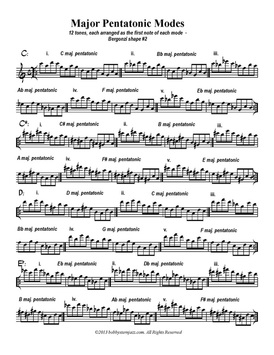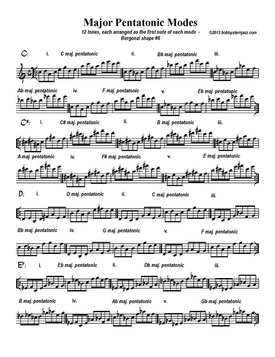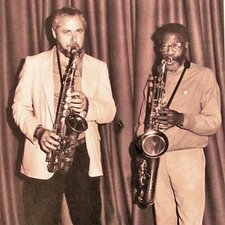
The Major Pentatonic Scale is derived from the Major Scale by omitting the 4th & 7th degrees. As there are 12 Major keys, there are also 12 distinct Major Pentatonics.
We can create 5 distinct modes from any pentatonic scale, one for each note of that scale.
If, however, we choose, to begin each mode on the same note, we then generate five individual pentatonic scales, each from a different key.
first tone of the "i mode" of C maj. pentatonic (C-D-E-G-A)
first tone of the "ii mode" of Bb maj. pentatonic (C-D-F-G-Bb)
first tone of the "iii mode" of Ab maj. pentatonic (C-Eb-F-Ab-Bb)
first tone of the "iv mode" of F maj. pentatonic (C-D-F-G-A)
first tone of the "v mode" of Eb maj. pentatonic (C-Eb-F-G-Bb)
In other words, there are 5 pentatonic choices for each of the 12 chromatic scale tones, giving us 60 pentatonic modes overall.
Then, factor in the 8 Bergonzi four note intervalic formulas or "shapes", and you've got something to keep you busy for quite some time.
What we're doing here this time is:
{(C) step down (A) skip step up (D) step down (C) skip step down (A) (pattern repeats)},
and #6,
{(C) step up (D) skip step down (A) step up (C) skip step up (D) (pattern repeats)}, (see graphics below)
Shapes 2 & 6 are linked, in that, as formulas, they are the vertical opposites, or seen as backwards, of each other. As lines, they also move in opposite directions (see graphics).
As with the other posts on note-centric pentatonic modes, this is a great, chops and vocabulary building technical exercise that sounds good and is fun and easy to play at any level.
Previous posts & downloads on the subject: Part 1 & Part 2.
Bass Clef Version Bass Clef Version


 RSS Feed
RSS Feed









